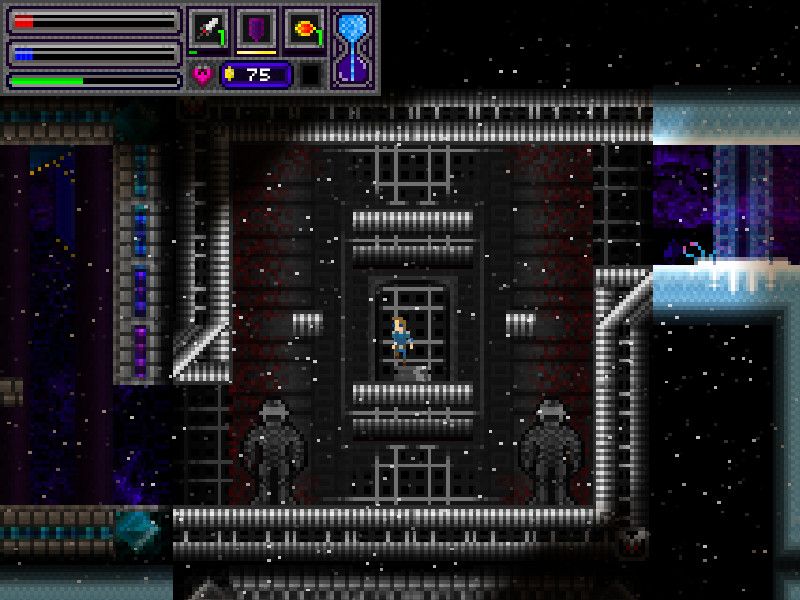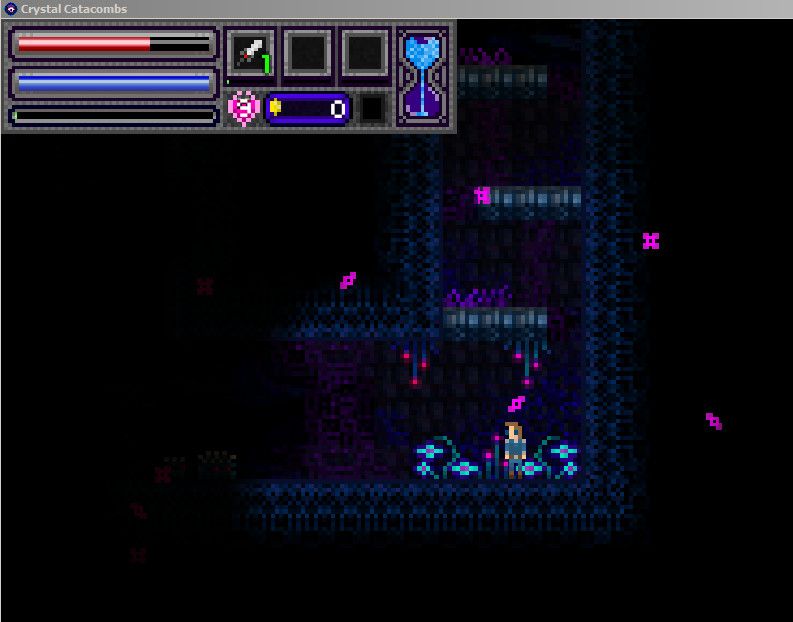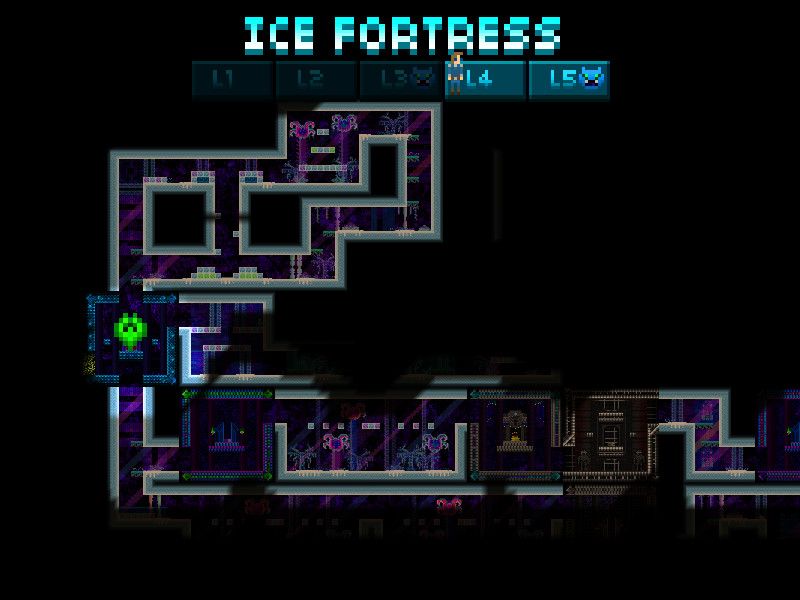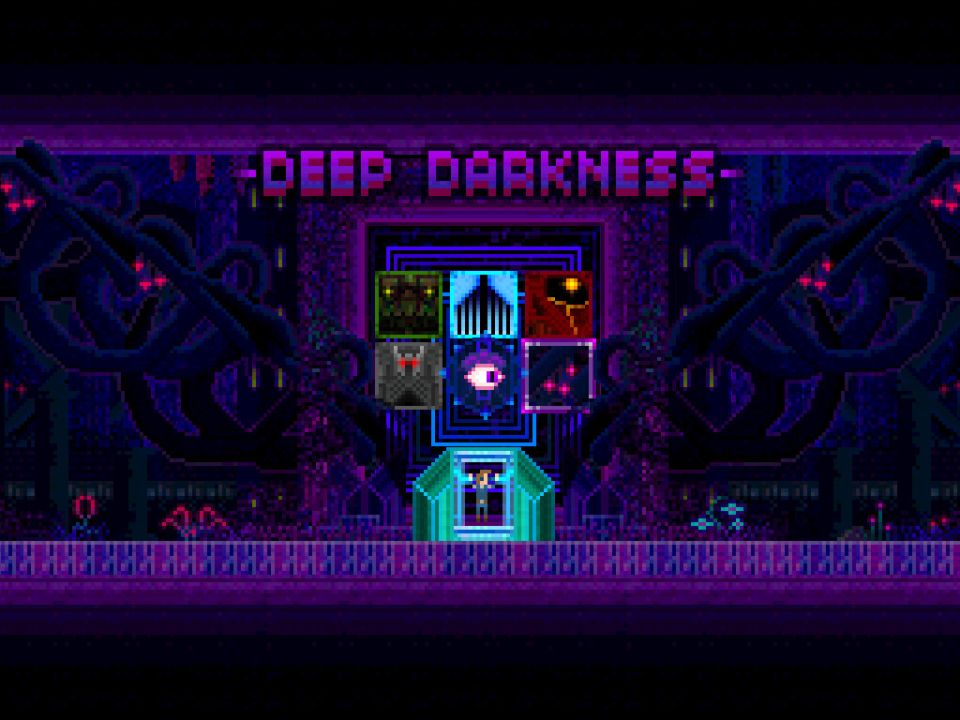Crystal Catacombs Review
You know a video game sitcom is going to happen eventually, right? They’re too big, too out in the open, too integrated into pop-culture, to go untapped for much longer. Sounds like a sobering thought, I know, but with a more positive outlook I think it could be a fun little exercise. Think about it: you invite some mates around, put on the telly, then point and laugh in derision at the heavy-handed attempts to portray an industry that’s growing far faster than the medium in which it’s being portrayed. And what of the games themselves? Rather than imagining how many swimming pools this venture will fill with petulant gamer tears, I’d like to speculate on what games would actually be featured in it. How do you unambiguously communicate an idea with only a few seconds of barely-visible gameplay? Does the frothy e-sports guy – played by Joel Gardiner, of course – indulge in Counter-Strike? DotA? Quake III? What about the inevitable slightly hipster-ish indie character with unkempt facial hair? Hotline Miami? Binding of Isaac? No, no, it has to be Crystal Catacombs.

Really, it’s hard for me to imagine a game that’s so quintessentially indie in every aspect of its construction. For sure, we’re basically swimming in retro side-scrollers with low-res pixel-art visuals, and even those that incorporate roguelike elements are a dime a dozen, but there’s a distinct amateurish charm to Crystal Catacombs that reminds you, with every step, that it was almost certainly conceived and programmed in an attic. It’s a product of many features: the way the game refuses to acknowledge that 1920×1080 is a resolution that people use in 2015; the way it comes with no manual, tutorial, or meaningful hints whatsoever, leaving you to prod and poke it until the game mechanics make sense; the way it doesn’t let you rebind your keys from the main menu, for whatever reason; the way it references old video games with every chance it gets. It’s the kind of game that you could sit people in front of and they’d assume it was created for the express purpose of exaggerating a stereotype. “Pff, that can’t be real,” they say, but it is. It’s not too bad, either.
So how does this one play out? You get to play Captain Vasil Ravencraft, a fearless, pioneering, swashbuckling lone wolf straight out of somebody’s self-insert fanfiction, who is out searching for the Crystal Catacombs, a sort of ‘greatest hits’ playlist for classic platformer levels. Unfortunately his fabulous flying airship bumps straight into the Crystal Catacombs’ guardian, which looks for all the world like the gooey offspring of a Metroid and a Cacodemon, and he is imprisoned in its domain. Still, even if its name is ‘The Destroyer’, it lets him out to play in the various worlds on a regular basis, so it can’t be all that bad. Such is the framing device – not a bad framing device, mind – for going to all the levels and beating all the bosses; the part of the game we actually care about.

What kind of game, you ask? Allow me to present a snippet of our upcoming cultural laughing stock:
“So they’re calling it a Megavanian,” says Indie Beard – as he is officially referred to in the script – over lunch one day.
“You mean a Metroidvania?” asks his clueless conversation partner, nose-deep in a laptop on the other side of the table.
“No, Megavanian. I wouldn’t expect a mainstream casual like you to understand.”
“Neither does anybody else, apparently,” smirks Laptop Guy, swivelling his screen to show the first page of Google search results.
Fake-sounding audience laughs. Funky jingle plays. Commercial break rolls. Nevertheless, while the self-assigned portmanteau of Mega Man and Castlevania might be a mite underused – by which I mean, completely made-up nonsense – it succinctly describes the particular brand of meticulous, unforgiving, old-school side-scrolling action that Crystal Catacombs encompasses, for better or for worse. It’s the kind of game where your enemies are about as threatening as a group of naïve tourists, but your own capabilities are so artificially stunted that you’re still in constant danger. The only control you have over your jumps is to completely reverse their direction – which is still more than the original Castlevania, so I suppose I need to act grateful – and apparently that overhead sword swing of his is so demanding that Captain Vassal Dravenhart has to stop dead in his tracks secure his feet to the ground with shipbuilding rivets before he feels sufficiently planted to attack. Now I’m not saying that forcing the player to work within limitations is necessarily a bad idea – imagine how dull Contra III would be if you could aim with the mouse – but when I’m eight hours in and still wrestling with the controls more than my actual foes, I’m about ready to pack it in. This is exactly the reason why most retro games made today focus on our ideals of old-school gaming rather than the reality.

You know what the early Mega Man games definitely nailed, though? Level design. With their rigid gameplay style, all it would have taken is a slight shift in enemy placement or a poorly-placed tile here and there to turn NES controllers across the country into tiny piles of greyish plastic, and as a self-proclaimed bearer of that same torch, the onus is on Crystal Catacombs to live up to that standard. Wisely, it stitches together pre-fabricated areas in a manner not entirely unlike Spelunky, so you’re guaranteed that at least some measure of design has gone into the structure of each room, but the game still has an uncanny knack for placing enemies with all the care of the world’s most apathetic dungeon master, with predictably frustrating results. Fighting in vertical shafts is my number one bugbear, since all you can do about enemies beneath you is toss out passive-aggressive comments – or drop bombs, assuming you’re lucky enough to find some – but thanks to the finicky controls pretty much any enclosed space is a nightmarish exercise in accidental wall-jumps, attacking while facing the wrong way, and losing half your health bar because your fixed jump arc landed you squarely on a monster’s toes. Oh wait, I got that part wrong. What I mean is that I’m rubbish at the game and it’s entirely my fault for not mastering its intuitive setup. That’s how it goes now, right?
Chin up, Crystal Catacombs; it’s not all bad. In an increasingly troubling world of games that slap roguelike elements on like cheap paint on a used car, Crystal Catacombs earns a gold star for actually putting some thought into it. Good roguelike elements significantly alter the core experience with each playthrough, while bad ones just rearrange the rooms every now and then and hope you don’t notice you’re really playing the same game every time. With gameplay this tight, where a few pixels here and there can make all the difference in the world, it’s no surprise that Crystal Catacombs does well here. Sure, the totally-not-Simon-Belmont’s whip might only have a tiny bit of extra reach than the sword and lack an overhead attack, but it’s enough to completely alter the way you approach scenarios. Same goes for the other weapons you can find, all of which prove beyond a shadow of a doubt that Captain Basil Cravenraft really is living in a NES crossover fanfic. With the fireball, you can take on enemies from a distance and bypass the whole ugly business of dodging their attacks; with the Wave Beam – yeah, they call it that – you don’t even have to be in the same room as them, or on the same footing. That’s a new dimension to gameplay, not some pedestrian health upgrade that pushes you ten hitpoints away from death. There are even potions with mystery effects, just like dear old Nethack used to do.

Here’s the thing, though: if a good roguelike is like dipping your hand into a tub of Lego bricks and building something out of whatever you pull out, then Crystal Catacombs is like dipping your hand into the same tub, rummaging around concernedly for a bit, then taking a peek inside to discover that it contains five bricks, a couple of wheels, a gear, a chewing gum wrapper and a dead silverfish. It has the principles down, and even the right environment to implement them, but there just aren’t enough items to actually create variety. While each individual weapon might have a profound effect, there are only a handful of them in total, so after a single playthrough you’ve seen pretty much everything there is to see. Upgrades and consumables suffer a similar problem, in the sense that they often massively change the course of gameplay – turning you invincible, granting you the power of flight, summoning a gaping hellspawn to butcher that one boss you can’t seem to get past – but there are barely enough of them in total to fill a shopping bag. Spelunky got away with this because the complex interactions between its level elements provided innumerable new platforming challenges with every reflexive smash of the ‘restart’ button; Crystal Catacombs just has stuff that sits around and hurts when you touch it, and consequentially can’t compete on that front.
By the way, remember how I was so enamoured with the game for its… let’s say, bumbling nature? Yeah, turns out the charm of a cute puppy soiling the living room rug only stays endearing as long as you’re not the one cleaning it up. Numerous times I was locked in the map or inventory screen by some manner of arcane bug and had no choice but to restart the game, something that would have soured the experience with a dustbin full of lemons had I made the mistake of playing the ‘proper’ roguelike mode. One time I consumed a mystery potion and had the misfortune to be teleported into a solid object – something I could have perhaps mistaken for a breathtakingly audacious stroke of malice had it not trapped me there permanently without so much as a ‘game over’ – and there’s at least one enemy that has such disdain for the game’s platforming that it just decides to skip it entirely, regularly teleporting straight to the ground beneath it halfway through a jumping attack, no matter how many storeys away that happens to be. If that’s a deliberate design decision I will eat a stack of post-it notes.

Ultimately the problem with Crystal Catacombs is that it’s just somewhat dry. From a design perspective there isn’t all that much wrong with it – frustrating platforming aside – but it’s so shallow, safe, and devoid of fresh ideas that after five minutes with it my eyelids feel like they’ve been tied to an ocean liner anchor that’s just been thrown overboard. It feels strange to use the term ‘generic’ in a space that has – traditionally, at least – so brazenly disregarded the messy little pigeon holes we use to define genres, but it’s the word that springs to mind again and again. In the triple-A market, or in the indie sphere, it’s the one label guaranteed to ensure apathy. That or a deal with a television producer.
